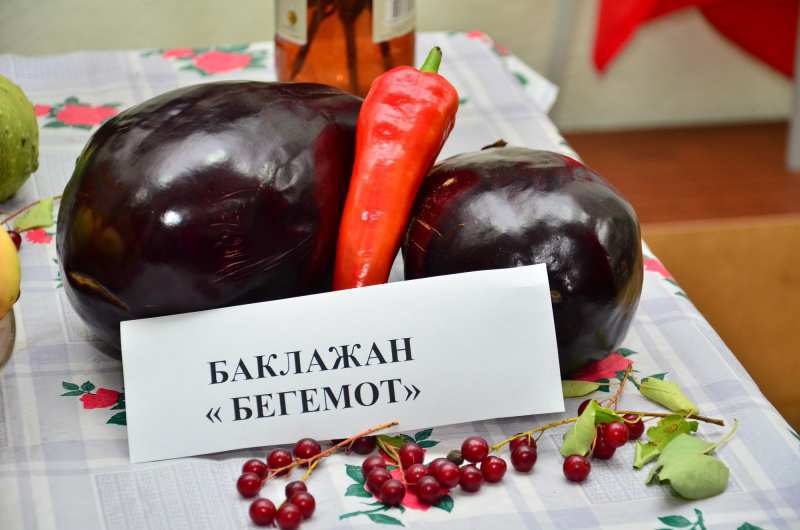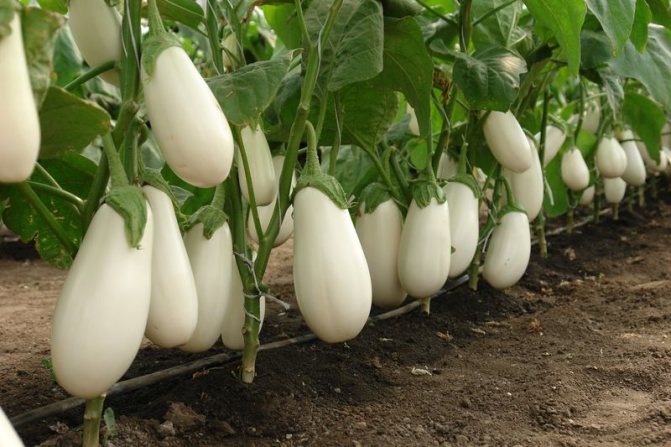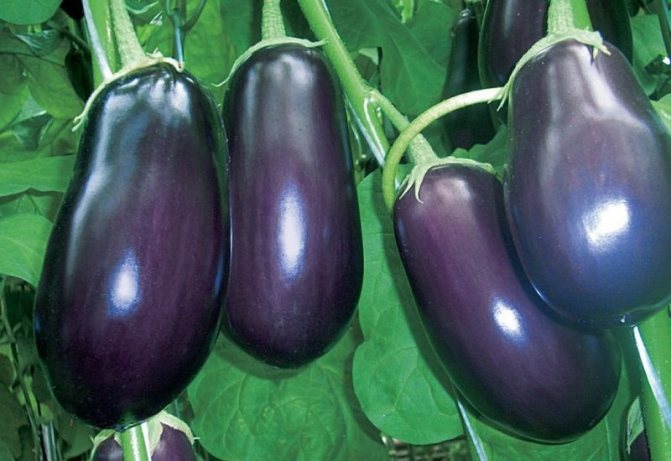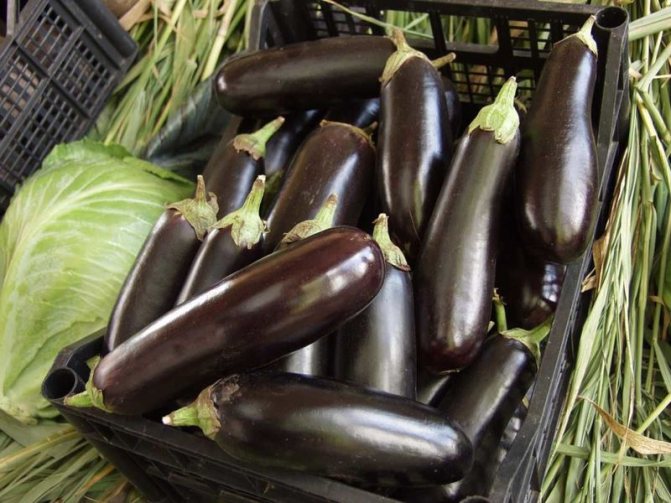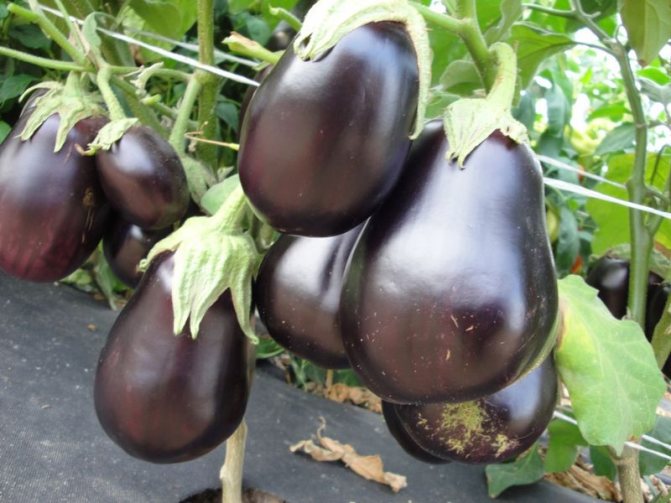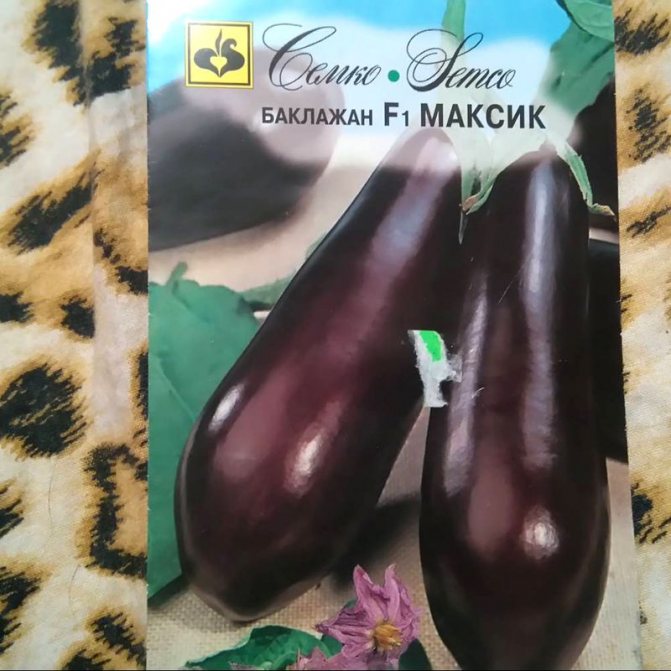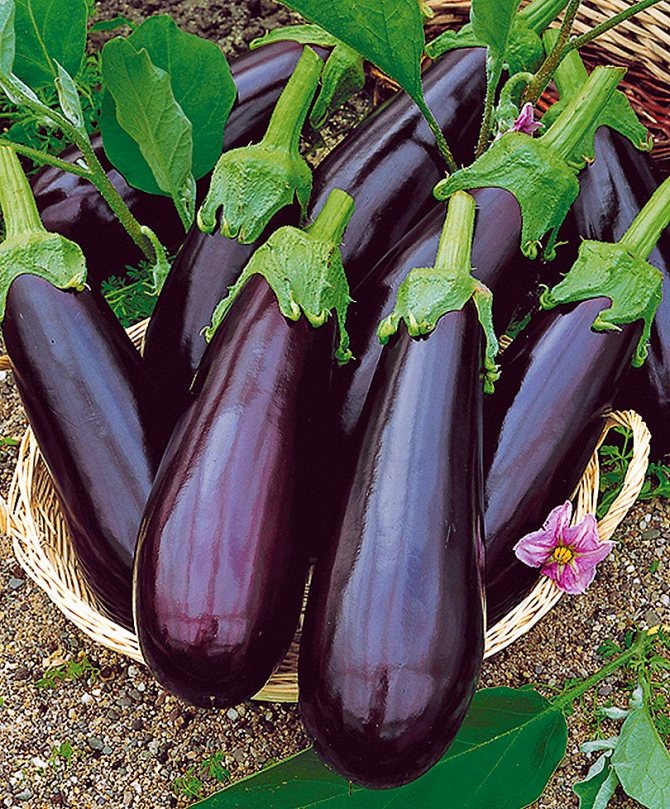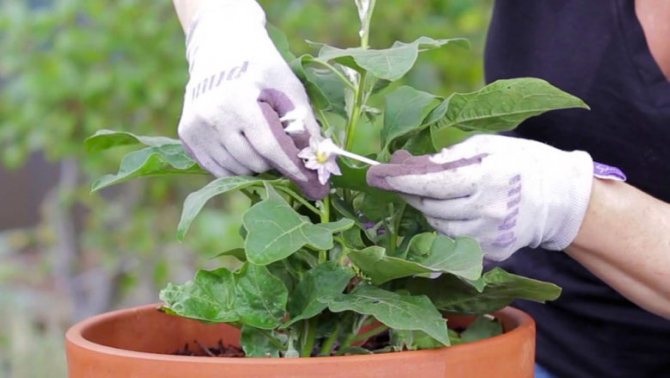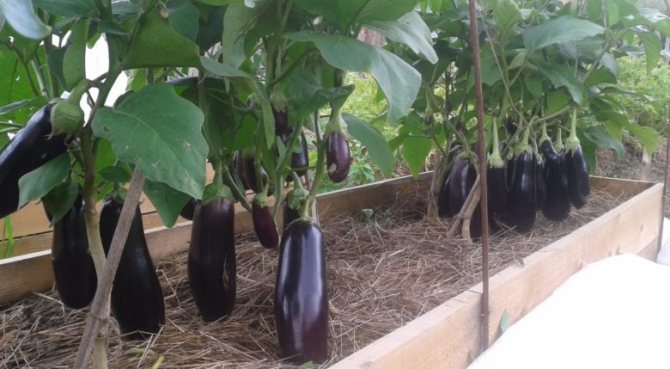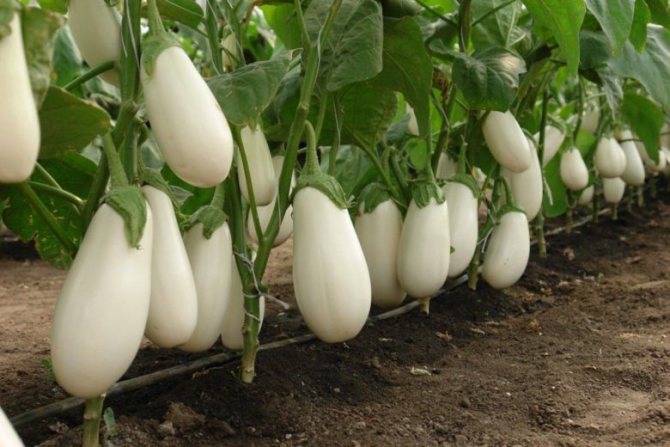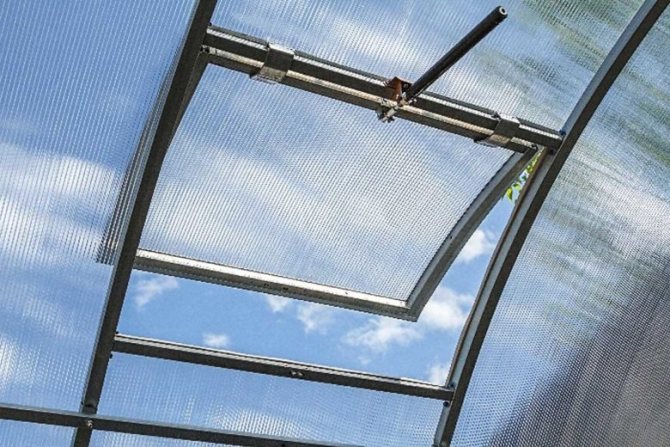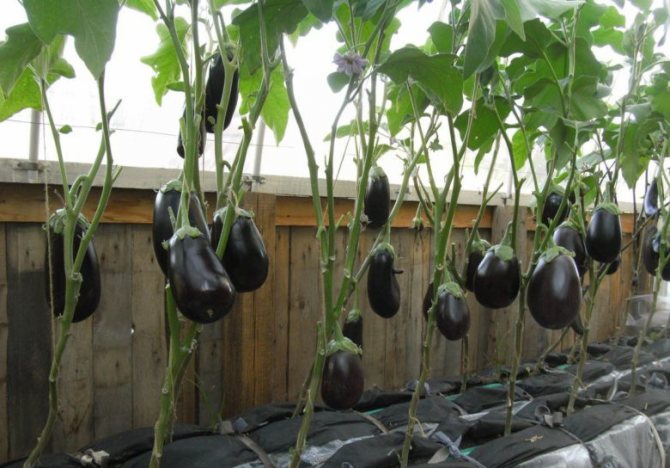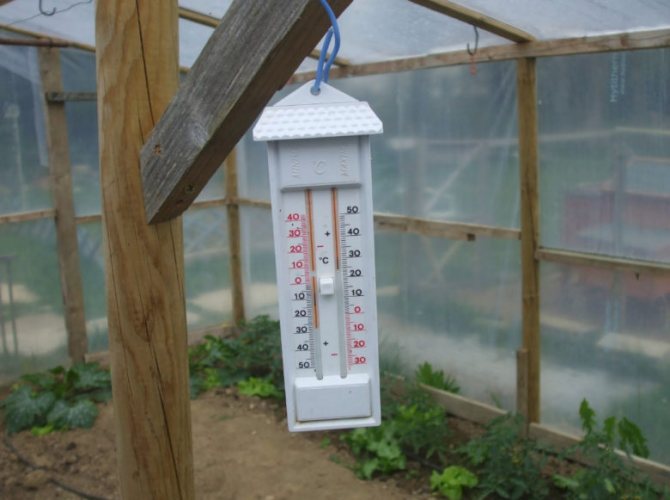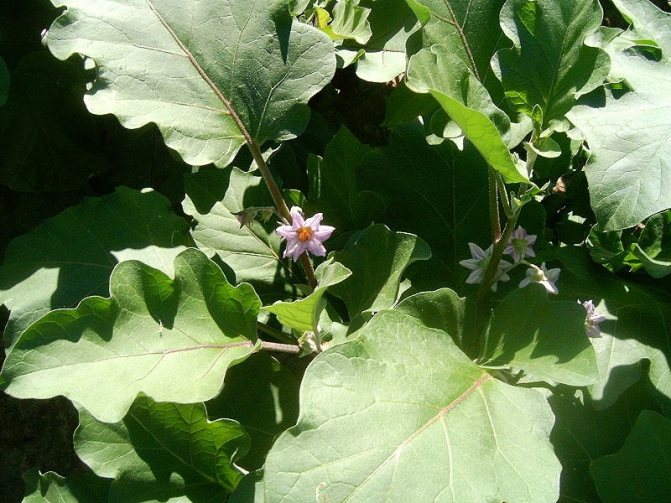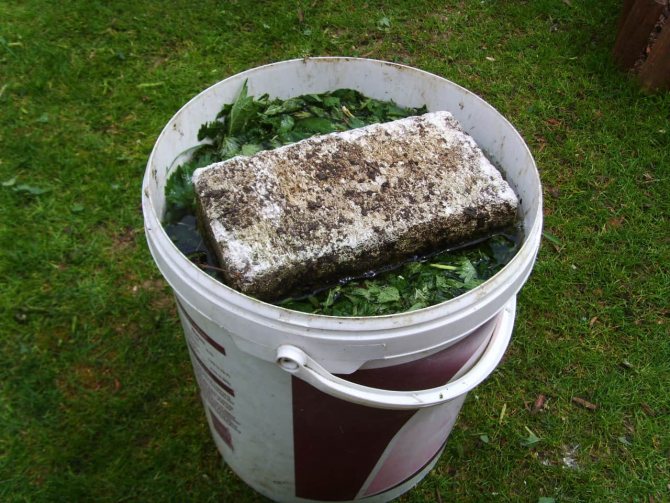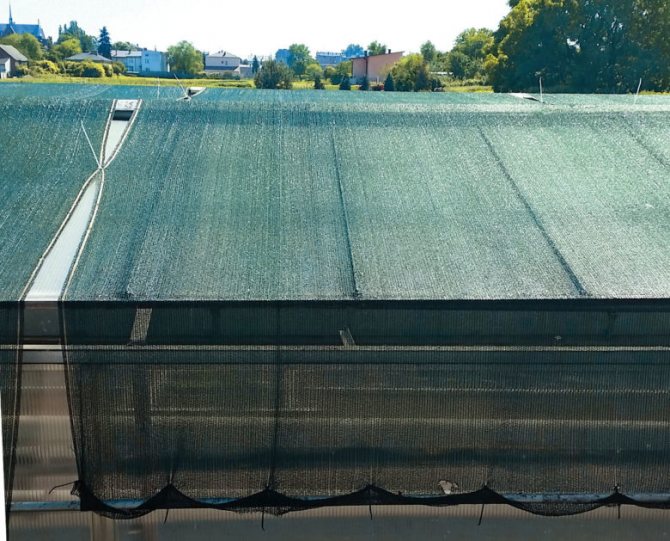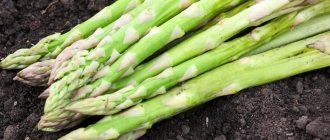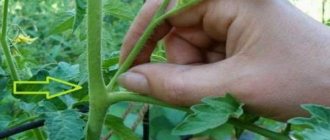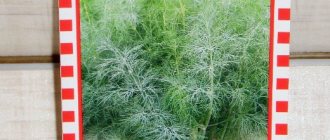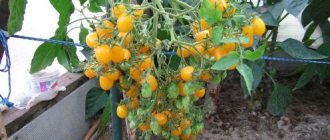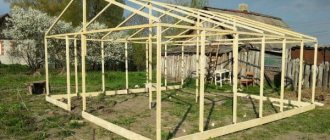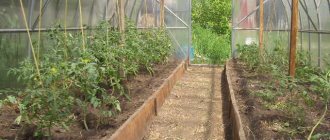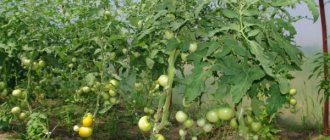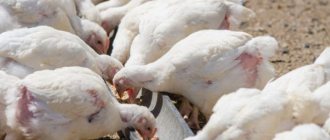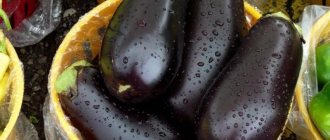Growing eggplants, not only in the open field, but even in greenhouse conditions, is not an easy task for a Russian gardener and, in part, even risky. And the point is not only in the capriciousness of this native of distant India, but also in the fact that caring for the "blue" is significantly different from the usual agricultural technology of growing other vegetable crops. But it is worth doing this, if only because the eggplants grown in our own greenhouse can with good reason be considered the “diploma work” of an experienced gardener.
Is it possible to grow eggplants in a greenhouse
Growing eggplants in the open field or in a closed greenhouse becomes a real challenge for every gardener. Not everyone succeeds in passing it, especially when it comes to the cultivation of vegetables in the Urals or Siberia.
The harsher the climate, the more unprofitable agricultural technology., because the culture develops well only under a certain temperature regime. It will not be possible to do without a heating system in the greenhouse, which means that another item of expenses falls on the gardener.
There is no need to worry about the possibility of cultivating the southern fruit in the middle zone and Siberia. Thanks to the painstaking and long-term work of breeders, it was possible to develop varieties that are resistant to cold and disease.
Popular hybrids include: Sailor, Robin Hood, Almaz, Albatross, etc.
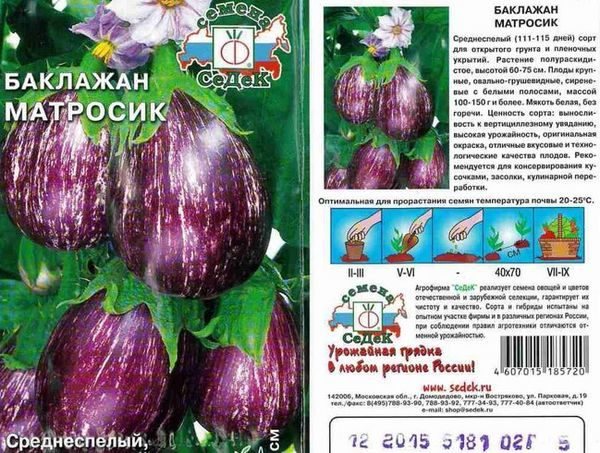
Sailor
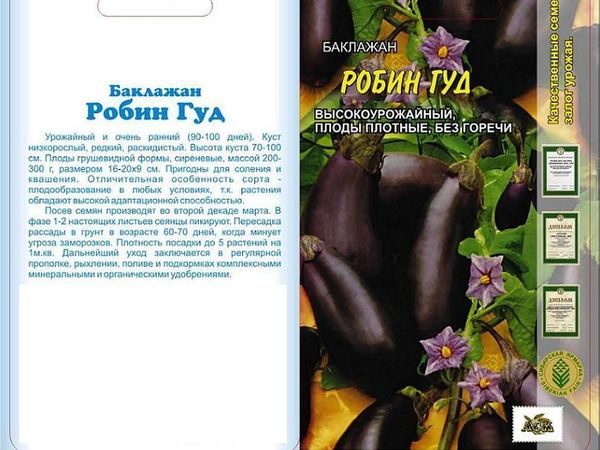

Robin the Hood
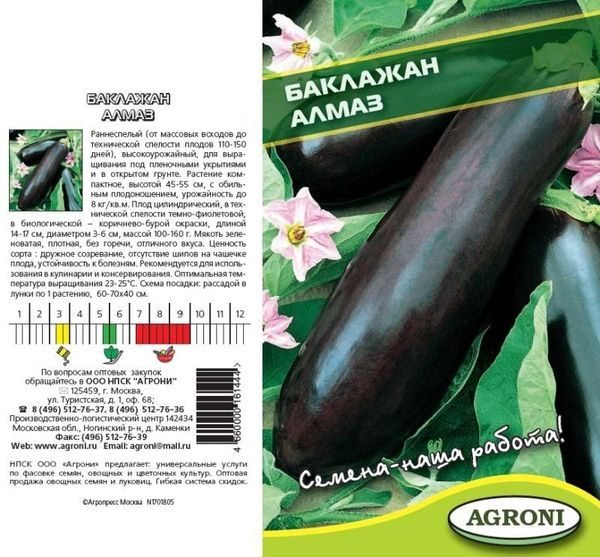

Diamond
Principles for the selection of varieties
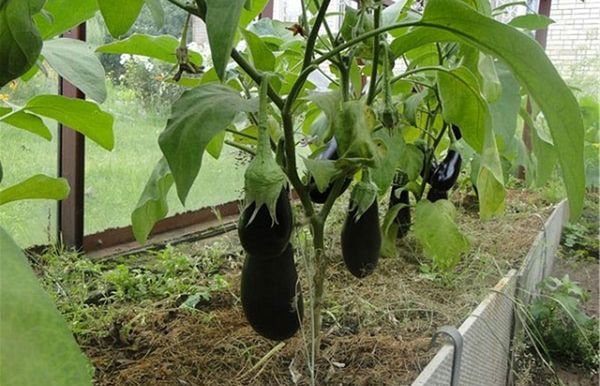

Breeders have worked for years to identify and combine the valuable properties of cultivated plants. When choosing which variety of eggplants to plant in a greenhouse, an amateur gardener must take into account several factors:
- Aiming at a gradual, long-term yield.
- Early or mid-early dates of the first collection.
- Delicate taste.
- Decent productivity.
- Disease and pest resistance.
- For exotic lovers - the unusual shape and color of the fruit.
- The height of the stems is from 70 cm.
In greenhouses, it makes no sense to plant undersized plants: tall bushes are more productive. So the greenhouse space is used more rationally.
The trend in recent years is the transition to hybrids, since they are more powerful and more resistant to contrasting temperatures. It is noteworthy that Russian selection is popular in eggplant culture.
The assortment also depends on the design features of a particular greenhouse (especially its height).
Basic requirements for growing in a polycarbonate greenhouse
Eggplant agrotechnology is simple, but it has some peculiarities.
The main secrets include:
- the correct selection of the variety (the assortment for greenhouses includes more than 20 varieties of vegetables that are cold-resistant);
- greenhouse construction must have vents to be able to change the temperature regime and carry out ventilation;
- to maintain the temperature, the greenhouse is equipped with heating system (for regions with a harsh climate);
- daylight hours for the plant should be within 12 hours, in case of a lack of lighting, it is recommended to install fluorescent lamps;
- watering is carried out warm water (24 degrees), irrigation should be started from the 5th day after planting, try not to spray the foliage;
- the soil should be fertilized, the structure is loose;
- at the flowering stage, excess flowers are removed (rationing of the fruiting process);
- as the culture develops, systematically introduce nutritional supplements.
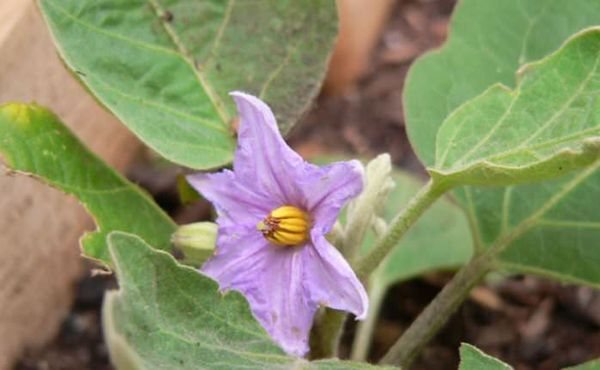

At the flowering stage, it is necessary to remove excess flowers
It is recommended for novice gardeners to master the eggplant agricultural technique precisely in greenhouse conditions, where the plants are protected from winds, scorching sunlight and other vagaries of the weather.
Soil and seed preparation
Quality seeds are the key to success when harvesting from an eggplant crop. But before sowing plants, one must not forget about disinfection and filling the soil with useful substances.
If the seed is collected with your own hands, then it is advisable to disinfect it as well. A slightly pink solution of potassium permanganate is suitable for this, in which it is kept for a third of an hour. After that, they are washed and placed in ash diluted with water. The seeds should stay in this nutrient solution for a day - this procedure increases the percentage of their germination.
Then they are taken out and wrapped in a damp cloth for another day. During this time, the seeds will already hatch. And if you use this method of preparing seed material, then the seedlings will be in 5 days. In other cases, you need to wait for the emergence of young plants for two weeks.
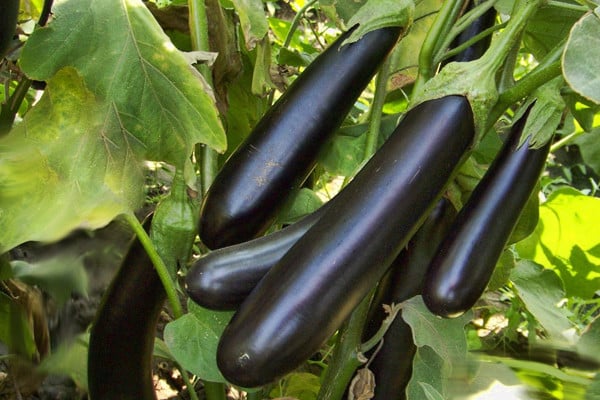

How to choose a greenhouse for planting outside open ground
The best option is a greenhouse or greenhouse from polycarbonate, it is able to protect eggplants from freezing and provide enough light and is easy to make with your own hands. On sunny days, the material warms up well, which reduces heating costs.
As an additional insulation layer is used inner lining with anti-condensation foil.
Eggplants do not differ in high growth of bushes, so there is no need for a large structure, it is enough to choose an option convenient for service with indicators from 1.8 to 2.5 m.
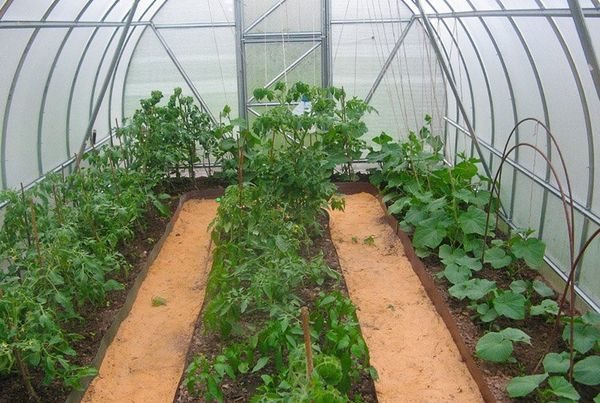

For growing eggplant, a greenhouse with a height of 1.8-2.5 m is suitable.
In regions with harsh climates, the greenhouse is better set on a foundation, a fairly lightweight construction with a depth of 20 cm below the ground level. The frame can be made of both wood and metal profiles. The presence of vents for temperature regulation and ventilation is considered mandatory.
When calculating the profitability of a greenhouse, it must be borne in mind that 3-4 plants are placed per 1 m2.
The yield indicated on the seed label is in reality lower, therefore the figure is reduced by 20-30%. The number of shrubs planted depends on the area of the greenhouse where they will grow. If it is built specifically to plant vegetable crops, then both the parameters of the material for the cladding and the ability to create the optimal temperature (heating) are taken into account.
In the greenhouse 2x3m can be planted 18-24 seedlings eggplant.
Greenhouse preparation
Anyone looking for an answer to the question "how to grow eggplants" should start with the first and main rule of agricultural technology: proper preparation of the greenhouse. It is necessary to start implementing this item in the fall. Initially, you need to remove everything that is left of the plants growing in the greenhouse.
If the greenhouse structure is wooden, then it is recommended to paint it with a solution of bleach, and if it is made of polycarbonate, it is simply treated with a solution. The solution itself is prepared in proportions of 400 g of lime per 10 liters of water.
Soil preparation is divided into autumn and spring.
- Autumn soil preparation consists in loosening and disinfection with a solution of vitriol from copper (2 tbsp. l solution per 10 liters of hot water).
- Spring soil preparation Is its leveling and fertilization. Organic fertilizing in the form of compost and manure must be added to the substrate. Since eggplants do not like acidic soils, it is necessary to reduce acidity by adding dolomite flour (2 tablespoons per 1 meter of soil). The optimum acidity for the culture is 5.5–6.5 pH.The introduction of brown peat and sawdust into the substrate before planting will help maintain the level of moisture and looseness of the soil necessary for the culture; the soil is also fertilized with ash and calcium sulfate. After applying all the fertilizers, the soil is dug up.
Did you know? In Britain, the popular eggplant variety White Egg, which resembles chicken eggs in both shape and color.
Correct time to disembark
Eggplant seedlings are planted in open ground only when when the danger of night frost passes... This period in the middle lane is in the second half of May - early June.
In the greenhouse, work begins earlier, since the presence of a shelter excludes freezing of young shoots at sub-zero temperatures, and the daytime sun will warm the walls of the structure and create the necessary conditions for the development of culture. When planning the timing of planting, the peculiarities of the greenhouse and the climate of the region are taken into account.
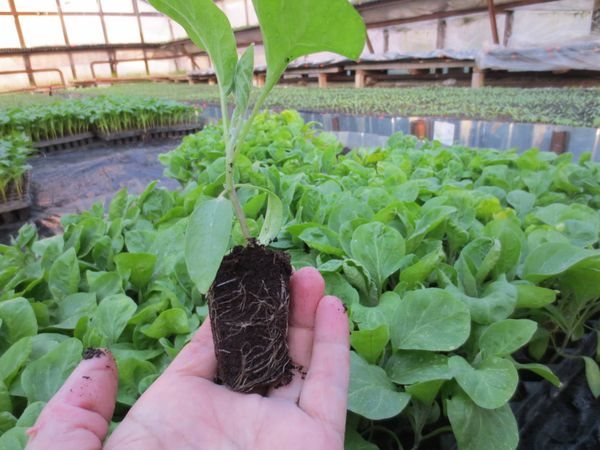

Until the transfer of seedlings to the garden, at least 65 days pass
If the seedlings are grown on an industrial scale, then the sowing is done from mid-February to early March... At least 65 days pass before the seedlings are transferred to the garden, which means that a transplant can be planned in early May. It is possible to shift the sowing and transplant dates by 7-10 days, if certain conditions are met.
In heated greenhouses, you can plant eggplant in the second half of January... Transplant dates with such a schedule are shifted to the beginning of April. This technology is not cheap, so it’s worth calculating the profitability first.
In the Moscow region, blue seedlings are transferred to greenhouses until May 10-15. In the Krasnodar Territory and Siberia, these events are planned for the second half of May, and sometimes the beginning of June.
Eggplants start as seedlings
Eggplants are so heat-loving plants that they are planted in a permanent place only in seedlings, both in open ground and in a greenhouse. It is convenient to sow seeds in ready-made packaged soil, enriched with the necessary additives. Before sowing, the seeds are soaked in a biostimulator (Zircon, Energen, Baikal Em, Epin), sown in cassettes with soil or boxes to a depth of 0.5-1 cm, slightly compacted. Before germination - it will take about 2 weeks - the containers are placed under a foil at a temperature of + 25-28 ° C.
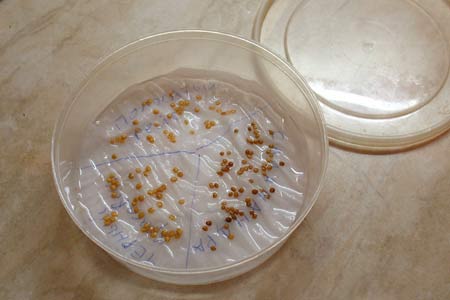

Soaking eggplant seeds in a biostimulator before sowing improves germination
When most of the seeds germinate, the containers are moved to a well-lit place, the temperature is reduced to about + 20-23 ° C. To the credit of eggplants, with some lack of light, they do not stretch like, for example, tomatoes, but they will benefit from additional highlighting. When the first true leaf appears, the seedlings from the box dive (transplant) into separate cups or peat pots.
On a note. To reduce stress, plants are sprayed with Epin-extra, Zircon on the eve of the pick.
After the appearance of 1-2 true leaves, eggplant seedlings dive
In practice, the author tested his own picking technology, after which not a single plant not only died, but also did not get sick:
- Before the dive, the soil is slightly dried, since it was a ready-made soil mixture, it remains sufficiently free-flowing.
- The sprouts are scooped up with a tablespoon with rounded edges, moving from the side of the box. Semi-dry earth is light, does not stick together an earthen lump, so the hanging roots do not become heavier and do not break off.
- In a cup half-filled with earth, the plant seems to "pour out" from a spoon.
- If the root lobe is large for the cup, the sprout is lifted, holding the stem, and the roots are laid in a circular motion in a spiral.
- The glass is filled with earth, which is compacted and watered.
For 2.5 months of "potted" life, seedlings are fed twice to choose from:
- ready-made complex fertilizer (Lux, Orton, Gumi-Omi, Lignohumate Joy);
- a self-prepared complex of 3 g of superphosphate and 1 g of carbamide or 4 g of Nitrophoska, dissolved in 1 liter of water;
- infusion of ash (1 glass of ash is infused overnight in 1 liter of boiling water, filtered, diluted in 10 liters of water), 20 g of infusion is poured under the plant.
The first time the fertilizer is applied 20 days after the pick. For seedlings sown in cassettes or cups, the feeding time is counted from the appearance of the first leaf. The second feeding - 20 days after the first. About 2 weeks before planting in a permanent place, the eggplants are tempered by airing the room at an external temperature of 12-15 ° C. The finished seedling has plump stems with 5–7 leaves, reaches a height of 10–12 cm, and the roots completely entangle an earthen lump.
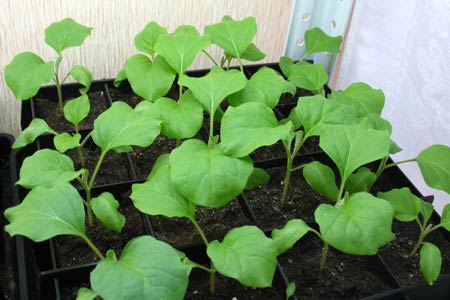

Strong eggplant seedlings will withstand transplanting better and adapt faster in the greenhouse
When to plant eggplants in the greenhouse
Eggplant seedlings for greenhouse planting should be 70–75 days old. The timing of disembarkation on greenhouse beds is considered by contradiction. First, the time period is determined when in the region (region, city, village) warmth sets in and the threat of return frosts passes. From this approximate time, the seedling age is counted back. For example, steady heat begins at the end of May. The following equation is obtained: May 25-29 (end of frost) - 70-75 days (seedling age) = March 15-19, that is, eggplants are sown in mid-March. In each region, the dates change depending on climatic conditions. It should be warm outside so that at any temperature fluctuations in the greenhouse it is kept + 15 ° C, and the soil warms up by about 20 cm.
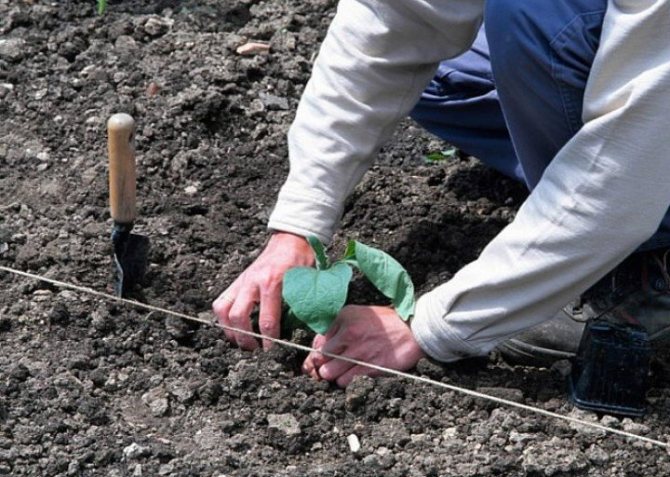

Planting eggplants in the ground is carried out only after the establishment of stable warm weather
A handful of wood ash is added to the hole, mixing it with the ground, pouring 1.5 liters of warm water or a pale solution of potassium permanganate (optional). When planting, eggplants are not buried, they are sprinkled with soil until the cotyledon leaves, squeezed with earth. If, after planting, dry hot weather is established, the seedlings are shaded with agrofibre, polyethylene until complete survival. When it comes to watering seedlings, many gardeners advise watering the hole before and after planting.
For information. Some practicing gardeners use the so-called Korean method of planting seedlings. Its essence lies in the fact that the plants are planted in the beds that were watered the day before and for a day or two after that they are not watered. This is explained by the fact that the earth remains looser and it is easier for the roots to straighten out in such conditions.
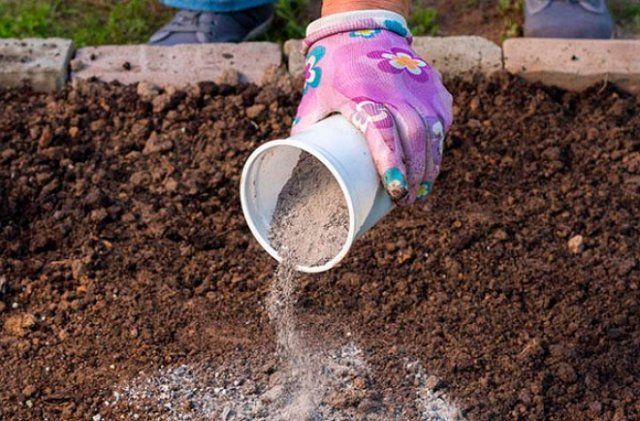

Wood ash enriches the soil with potassium, which has a beneficial effect on eggplant seedlings
Comfort zone or seating pattern
The leaves of eggplants are very large, the plants give a continuous shade, especially varieties with a spreading shape of bushes. Therefore, with thickened plantings, the seedlings are sorely lacking in light, ventilation between them is disrupted. Between neighboring plants in a row, 45-50 cm are left. If the bed is designed for 2 rows, the seedlings are planted in a checkerboard pattern with a row spacing of 60 cm.
Good and bad neighbors
If the agricultural technology of different crops is the same, and the pests are different, they will not oppress each other. The best neighbors for eggplant are:
- sweet peppers, because the tastes of both crops in terms of moisture, watering, application time and frequency of dressings are the same. If the beds are located next to each other, a distance of 70 cm is maintained between them;
- greens - basil, spinach, onion, lettuce, radish;
- Chinese cabbage;
- legumes.
The close proximity of hot peppers can negatively affect the taste of the eggplant fruit.... It is undesirable to have beds with tomatoes next to them, because dry air is harmful to them (tomatoes) during flowering and ovary formation, as well as during fruit ripening. Eggplant will be uncomfortable next to cucumbers, because the cucumber not only needs a lot of water, but also loves the humid atmosphere around it.
How to reconcile vegetables in a greenhouse
It is still possible to create the most comfortable conditions for antagonistic cultures (opponents) in a limited area. For example, a couple of eggplants and cucumbers are planted against opposite walls of the greenhouse. Blue will be good from the south side, and cucumbers - from the north. If it is also necessary to plant tomatoes, they are separated from the eggplants by a number of cucumbers.
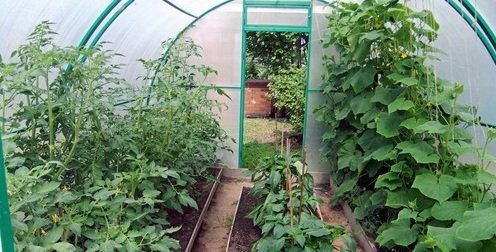

The neighborhood of eggplants with antagonist crops in the same greenhouse is possible by placing them in different zones
If possible, the greenhouse space is zoned with a film, hanging it along the garden bed. If the greenhouse has 2 doors, the film is hung across - on one half, they plant moisture-loving tomatoes, cucumbers and cabbage, and on the other half, eggplants, peppers and herbs.
Video: planting eggplants in the ground
What is the scheme for planting seedlings
When planting seedlings, the main thing do not allow the beds to thicken, this leads to lower yields and an increased risk of infection with fungal diseases.
1 m2 is located about five plants in heated greenhouses, no more than three - in unheated structures. When forming beds in rows, adhere to the following intervals:
- row spacing - 60-65 cm;
- the distance between the holes in a row is 30-35 cm.
The depth of planting of seedlings is 15-18 cm. Favorable temperature conditions for the adaptation of young shoots correspond to 18-20 degrees (on the ground at least 15 degrees).
For varieties with spreading bushes, a scheme with a staggered arrangement of holes (an interval of 60 cm) is more suitable. Low-growing plants are planted in 2 rows with a row spacing of 65 cm, the distance between bushes in a row is 40-45 cm.
Landing time and scheme
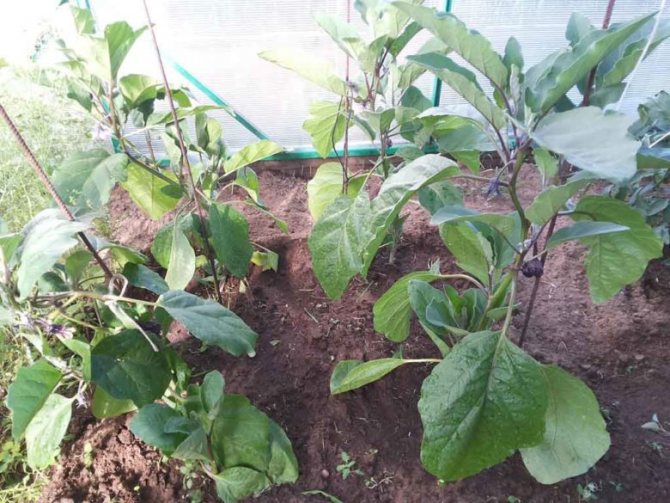

Eggplant bushes in a greenhouse
It is customary to plant eggplants in seedlings, so you can get a harvest more efficiently, more productively and faster. It is very important to choose a variety that is suitable for growing in greenhouse conditions. The timing of planting eggplant seedlings in the greenhouse depends on the regions, climatic conditions and weather. There is an early warm spring, or prolonged cold weather can last, which will not allow the soil to warm up. Eggplant seedlings are planted in an unheated greenhouse when the soil warms up to 15 degrees Celsius and a fairly stable positive temperature is established at least 18 degrees Celsius. In greenhouses with heating, seedlings can be planted much earlier.
For full growth and development, eggplants need enough space, and in order to avoid an outbreak of fungal diseases, good ventilation is necessary. Therefore, it is important to follow the eggplant planting pattern. Seedlings are planted in a greenhouse at a distance of 35-40 cm from each other and there should be at least 70 cm between the rows. The higher and more spreading the variety, the more you need to spacing between the plants. Then it will be convenient to take care of them and the risk of various diseases will decrease. Next, read about caring for eggplants in the greenhouse from planting to harvest.
Planting eggplants in the greenhouse
Care of the first shoots
After germination, seedlings need special conditions and temperature conditions. 18-20 degrees.
Lighting
For the normal development of young shoots, a daylight hours of at least 12 hours are required.
To ensure this condition, you will need to install indoors fluorescent lamps... Additional lighting should be evenly distributed over all seedling containers.
Watering
Excess moisture can lead to the death of the plant, so the seedlings are watered sparingly. Regularity of procedures - 1 time in 3-5 days... Water is introduced in small portions into the soil, not onto the sprouts.
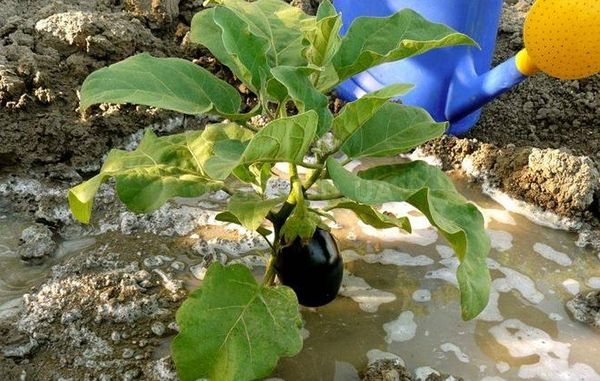

Watering eggplant in the greenhouse is carried out 1 time in 3-5 days
Top dressing and fertilizers
The first feeding is made after the first shoots appear... The choice of fertilizer is carefully considered, because the development of culture depends on its properties.
Some gardeners prefer liquid solutions, such as potassium nitrate (3 grams per 1 liter of water).When introducing liquid, try not to get on the greens, so as not to burn it. An ash solution is considered no less useful (a glass of ash for 7 liters of water). Fertilizer Kemira Lux (2 grams per 1 liter of water) has proven itself quite well.
The second feeding is applied after 3-4 weeks... The following products have not lost their relevance: Biohumus, Healthy Garden, Bioton. They are absolutely safe for the culture, but they do a good job with the task.
If the shoots have slowed down their growth, then it is recommended to use the following means: Agricola forte, Signor, Ideal.
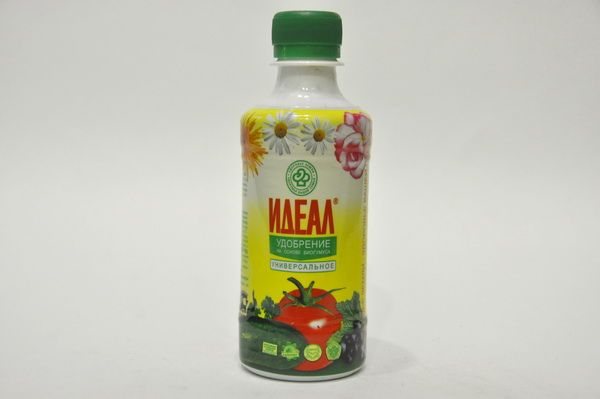

Ideal is suitable as a growth regulator for eggplant.
Diseases and pests
Eggplants can be affected by the following diseases, the fight against which should be started immediately after symptoms are detected:
- Late blight... Fungal disease reports itself with brown spots, which resembles rust. First, spots appear on the lower part of the stem, and quickly spreads throughout the bush, is thrown onto the fruit. Delay in the treatment process leads to the death of the bush. Treatment of all plants (both sick and healthy) with a solution of copper sulfate (0.2%) or Bordeaux liquid (also 0.2%) will help to overcome the disease. In this case, wood ash acts as an antiseptic, which should be sprinkled on the affected areas of the plant.
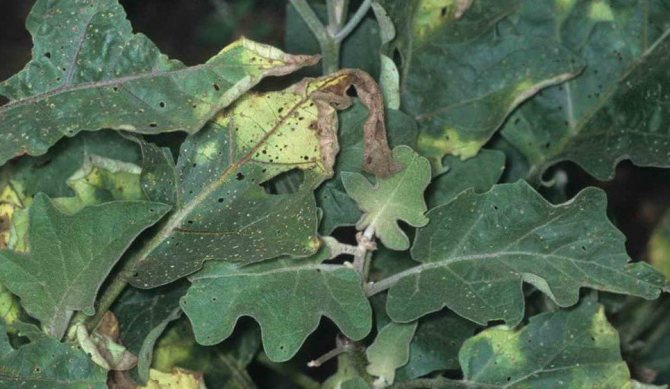

- Tobacco mosaic, the symptomatology of which is the loss of color by the foliage, or the appearance of green spots on it, resembling a mosaic. The disease can deform the bush and lead to its death, if the fight is not started in time, which begins at the stage of preparing the seeds for sowing. So, the eggplant seed must be placed in a 20% hydrochloric acid solution and kept there for 30-40 minutes.
Did you know? In the USA, Canada and Australia, eggplants were given the name eggplant (egg vegetable), since the first eggplants introduced there in the 18th century had a rounded shape and white color, resembling large eggs.Another stage of prevention is sprinkling the bushes with a mixture of skim milk and laundry soap (20 g of soap per 1 liter of milk). You need to spray the culture every 10-15 days. But if the disease, despite the prevention, attacked the eggplants, then the only thing that can be done is to remove the damaged bush from the greenhouse and burn it.
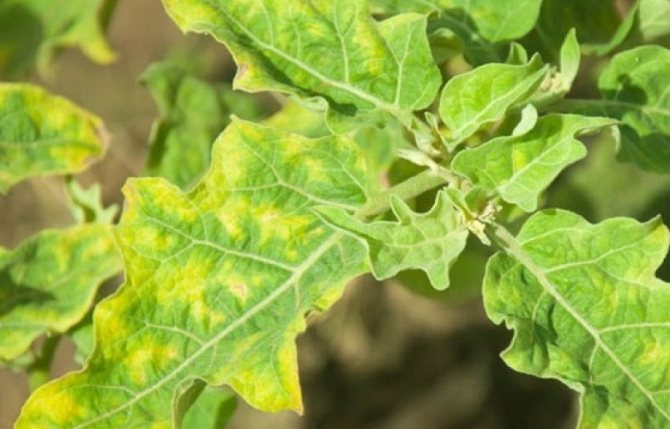

- Blackleg, damaging the root system of the plant and leading to wilting and early death of the bush. The cause of the appearance of the fungus that causes the disease is excessive soil moisture and dense plantings. The medicine for the black leg is the drug "Trichodermin", the solution of which is watered and sprayed on the diseased plant (the solution is prepared strictly according to the instructions). If the treatment does not help, the diseased bush must be removed before the fungi from it have spread to the neighboring ones.
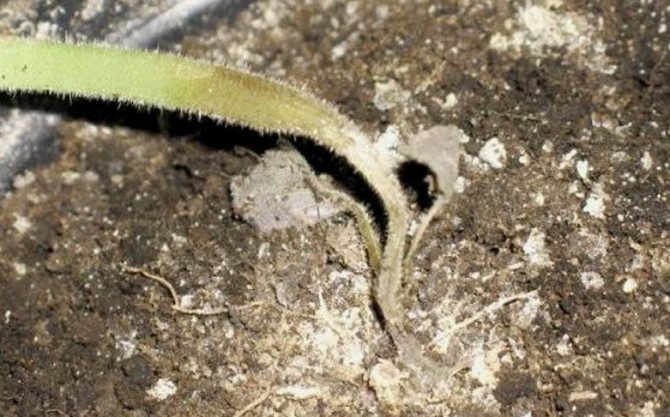

- Gray rot, the causative agent of which the culture can pick up from diseased soil, air. Also, the cause of the disease can be excessive moisture - both soil and air. The appearance of the disease is signaled by dark watery spots covering foliage, stems and fruits. The spots grow rapidly and become covered with a gray coating. The fight consists in removing the affected areas of the plant and treating the wounds with wood ash, as well as moderately watering the bushes with warm water.
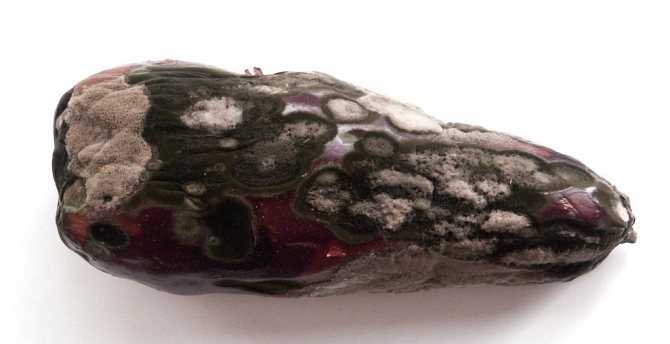

Pests dangerous for eggplants include:
- Spider mite, the main food of which is the juices of the culture. In the process of feeding, the mite envelops the plant with cobwebs, which can soon lead to its death. Spraying with Fitoverm (10 ml per 1 liter of water) will help drive away the uninvited guest. You need to spray twice, observing the interval of 3-7 days.
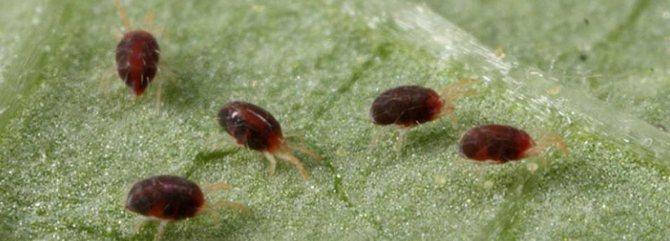

- Colorado potato beetle... The gluttonous insect quickly leaves some stems from the leaves. Control measure - manual collection of an adult beetle and destruction of larvae.
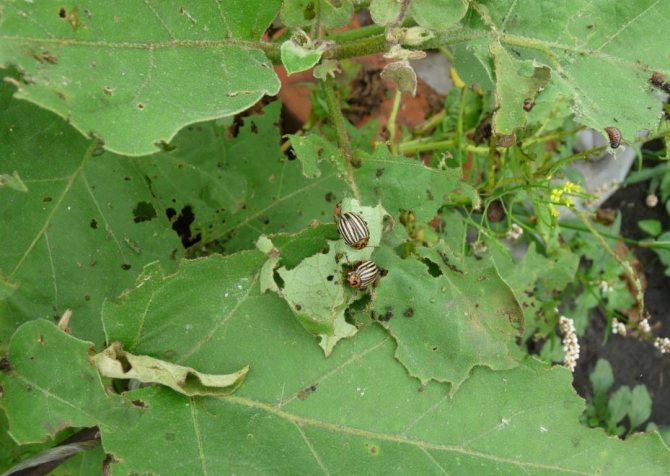

- Aphids, against which Fitoverm is also effective (8 ml per 1 liter of water). The procedure, as in the case of a spider mite, is repeated after 3–7 days.
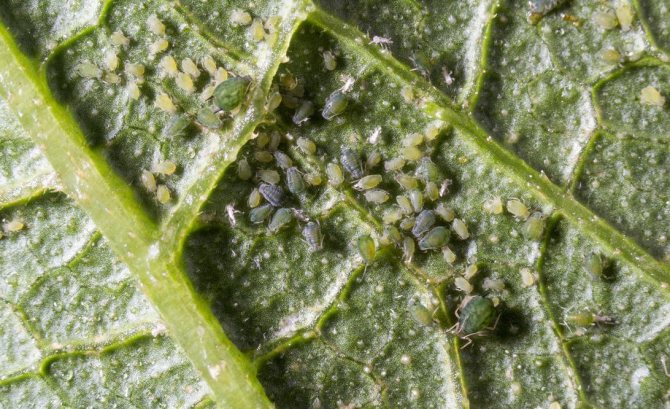

- Greenhouse whitefly, whose larvae suck the juices from the plant, which leads to the death of the foliage. To eliminate such an uninvited guest will help the processing of garlic tincture: 150 g of chopped garlic is poured with cold water and insisted for 5 days. Then 6 g of tincture is dissolved in 0.5 l of water and the affected bushes are sprayed. Sticky traps should be set for insect moths.
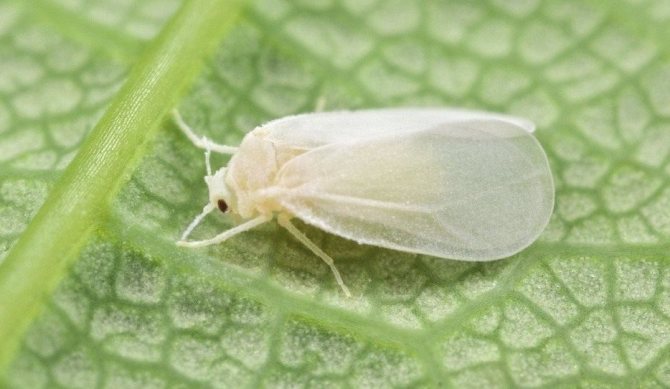

- Slugs, who are not averse to feasting on not only greens, but also the fruits of eggplants. To get rid of the pest, it is necessary to sprinkle the furrows with slaked lime, to which you can add shredded tobacco.
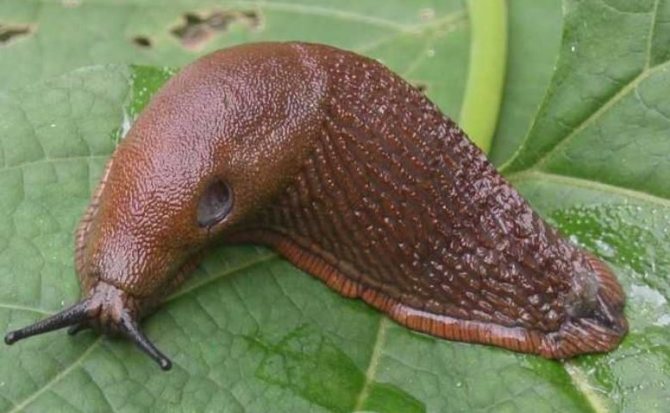

Care for grown eggplants
Pollination
The culture has bisexual flowers, the process of pollination occurs spontaneously... To enhance the effect in the morning, you can walk along the rows and shake each bush lightly. More drastic pollination measures are not provided.
Features of the formation of bushes
To increase fruiting, eggplant bushes must be pinned.
It can be formed in three ways: in one, two and three stems... The variant of plant formation is chosen solely taking into account the characteristics of the variety. Excess ovaries pull forces on themselves, preventing the rest of the fruits from developing, therefore, it is considered necessary to remove them.
When cultivating a vegetable in a greenhouse pruning is done 2 weeks after planting seedlings. For this, all processes located below the first branch are removed. After the formation of 4-5 shoots, pinch the top.
When carrying out this procedure, you can also focus on the height of the bush, it should be within 25-30 cm. For high varieties, you may need to tie up the bushes.
Watering and the necessary feeding
5 days after planting seedlings on greenhouse beds, you need to moisten the plants warm water... Further procedures to carry out at least once a week, better in the morning. Water is applied under the root of the plant to keep the foliage dry.
To maintain soil moisture, it is recommended mulch beds. This process replaces loosening, which is likely to damage the roots.
To prevent the development of fungal diseases, you need to regularly ventilate the greenhouse.
During the growing season, eggplants are fed 3-5 times... When cultivating a vegetable in a greenhouse, it is preferable to use complex fertilizers: Solution, Kemira universal (for a bucket of water, 1.5 tbsp. L. Means). After the formation of the ovaries, nitrogen-phosphorus fertilizers are used (for a bucket of water, 1 tsp. Ammonium nitrate, 1 tbsp. L. Superphosphate).
Organic products are also used for dressing, but they should not be overused, so as not to provoke an intensive build-up of greens. For eggplant, Biud is ideal (diluted with water in proportions of 1:20).
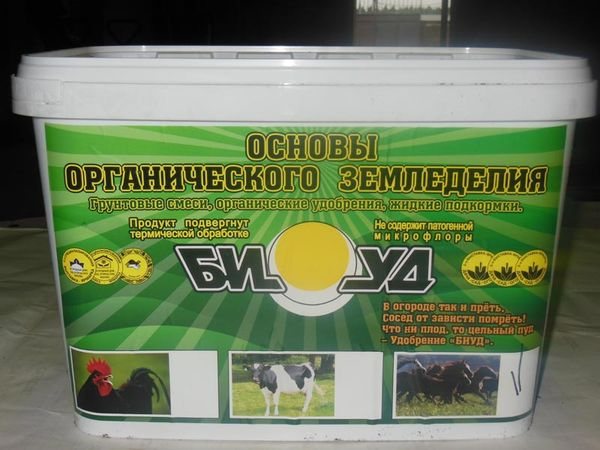

Biud is ideal as a top dressing.
Lunar calendar for planting eggplant
Those who adhere to the lunar sowing calendar (and do it very rightly!) Often encounter discrepancies in the published dates. In order not to get confused, you need to know that eggplants, like all aboveground vegetables, are planted on the growing moon. In this case, the plants. planted in the 1st quarter, will be stronger and shorter, and in the 2nd - they will stretch in growth and have a more unstable stem. In addition, the zodiac constellations, in which the moon is currently passing, have a great influence on them. The most fertile of them are Pisces, Cancer, Taurus and Libra, and the most barren are the drying Leo, Aries, Virgo and Gemini.
On the waning moon, when all the vital plant juices rush down to the roots, it is unfavorable to transplant "tops" vegetables, the harvest will be frail, and the roots may start to rot.


The days of the Full Moon and, especially, the New Moons require complete rest, it is categorically not recommended to plant anything on these days!
Possible difficulties in growing eggplant
When cultivating eggplant in a greenhouse, the following problems may arise:
- yellowing of the foliage (the reason often lies in the violation of the irrigation regime or the introduction of fertilizer, and the disease is also not excluded);
- falling off of the ovaries (occurs as a result of a lack or excess of moisture);
- the bush develops well, and the ovaries are formed poorly (the reason lies in excessive feeding with nitrogen fertilizers or lack of pruning);
- the plant blooms, but does not bear fruit (better pollination is required);
- leaves curl (possible reasons: pests, excess moisture, lack of light);
- spots on the leaves (more often the cause is direct sunlight);
- weak growth of shoots after transplantation (the slowdown in development is more likely associated with the root system, you need to feed "Kornevin").
Growing seedlings
Eggplant, like a cucumber, does not like transplantation very much and tolerates it extremely painfully. Therefore, avoid diving and sow seeds directly into biodegradable pots. The period for preparation and planting of seed is calculated based on regional characteristics and on the fact that the seedlings will be ready for transfer to the greenhouse in about 70 days.
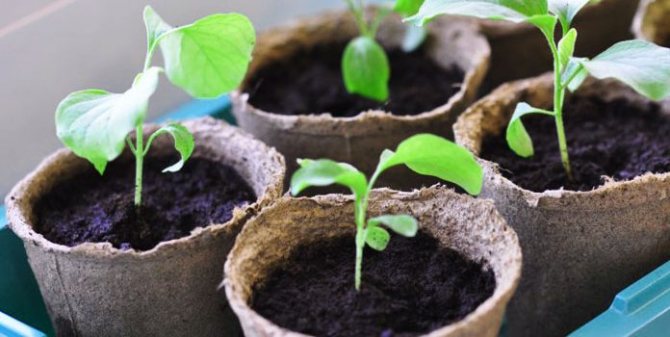

The best seedling soil is a mixture of turf, humus and sand in a ratio of 6: 4: 1. The sprouts will respond well to nitrogen, potassium and phosphorus fertilizing.
To get the strongest eggplant seedlings, put 2-3 seeds in each pot, and immediately remove the weaker ones after germination.
Harvesting and storage
Harvesting is planned for the ripening period of the variety. Technical ripeness occurs 25-40 days after the flowering of the seedlings.
You should not be guided by color, long before ripening, the skin of the fruit takes on a characteristic varietal color. The first clue would be degree of firmness of the pulp... When you press on the eggplant, a small dent will remain, which heals very quickly.
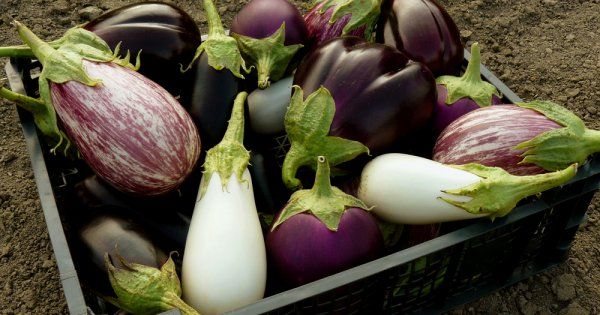

The degree of maturity of the crop is determined by pressing the fruit
Ripe fruits are cut with pruning shears, leaving a tail of 3-5 cm.Choose a cool one for storage. dark place (more often the basement). Vegetables can be placed in boxes in 2 layers. To keep the harvest longer, vegetables are shuffled with straw or parchment paper. It is recommended to make an audit every 2 weeks in order to remove perishable copies from the box.
Choosing a variety or hybrid for greenhouse cultivation
Before growing your eggplant in a greenhouse, choose a variety that suits your needs. At the same time, take into account several important criteria: ripening time, estimated yield, degree of thermophilicity, requirements for growing conditions: soil, lighting, etc. Preferred varieties are early ripening, with large fruits (they ripen faster). The height of the eggplant bush also matters - the yield of tall plants is always higher. But vigorous eggplants are more demanding in their care - they must be tied up and the bush must be properly formed. Please note that greenhouse varieties are mostly low and medium-sized, while hybrids, on the contrary, are tall.
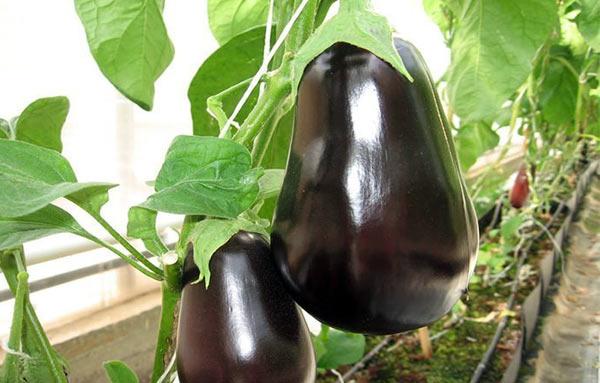

By the timing of ripening, they are divided into 3 groups:
- early ripening - 3.5 months pass from the moment of planting to harvesting;
- mid-ripening - the growing season is 4 months;
- late ripening - more than 4 months pass from planting to ripening.
There are a sufficient number of varieties of this vegetable suitable for planting indoors. Here are some of the hybrids and varieties for the polycarbonate greenhouse:
- Bard F1. This is an early hybrid. The bush is high, moderately spreading, densely leafy. Fruit of regular cylindrical shape, weight up to 85 g. The flesh is greenish, not bitter, very pleasant to the taste.
- Balagur is a variety of early ripening, resistant to diseases. Bushes up to 1 m tall.
- Vakula is an early ripening variety with high yields and excellent fruit taste.
- Alenka is a variety with a white-green color of ripe fruits that grow up to 15 cm.
- Sophia is a late variety.Vigorous bushes, pear-shaped fruits, excellent keeping quality.
- Helios is a medium-early ripening variety. The bush is tall, the fruits are round with a dense creamy flesh of an unsurpassed delicate taste, reminiscent of mushroom.
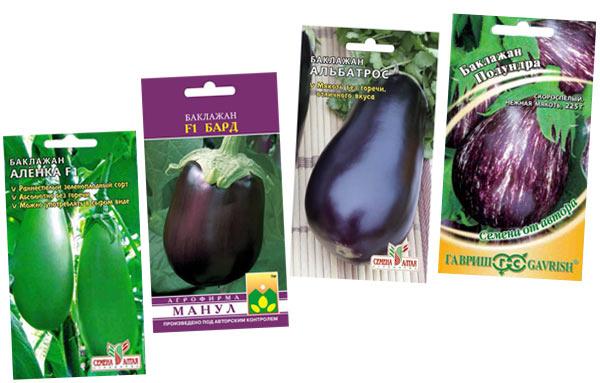

- Pink flamingos are an early cultivar. The bushes are tall, semi-spreading. Fruits are elongated, narrow, slightly curved with mauve skin and white flesh.
- Robin Hood is a fast ripening variety with pear-shaped fruits.
- Albatross is a variety with fruits about 15 cm in size, it is distinguished by its yield.
- The namesake is a mid-season variety, has a high yield, and is resistant to diseases.
- Semundra is a mid-season variety with oval fruits, which have a white rind with pink strokes and tender white flesh.
- Filimon is a mid-season variety. The bush is vigorous, the fruits are very large, ovoid. The pulp is white, not bitter.
- Black Moon - delicious taste eggplants, ideal for canning.
- Fabina F1 is a fast ripening hybrid that produces fruits without bitterness.
- Black handsome - early ripening low hybrid with dark purple fruits, without bitterness.
- The purple miracle is the eggplant, which can be grown even in the northern regions.
- Sperm whale is a very early and productive variety. The bush is vigorous, semi-spreading. The fruits are large, pear-shaped, with a lilac skin.
When choosing eggplants for growing in a greenhouse, pay attention to a few more selection criteria. These are the climate of the area, the type of greenhouse, the resistance of the variety or hybrid to diseases and the desired yield. The variety chosen should meet all of these requirements as best as possible.
Bagheera
Mid-early hybrid - the ripening period is 100-110 days from the day of sowing seeds for seedlings. A distinctive feature of the variety is its high yield (10-12 kg / 1 sq. M) and the simultaneous ripening of fruits. The hybrid is quite resistant to diseases, but demanding of constant temperature and humidity.
The culture was bred specifically for greenhouses. In greenhouses it is customary to grow it according to the so-called "low-volume" technology - in separate small containers with a special substrate, which is very convenient in a small greenhouse.
The variety is compact bush. Fruits are oval, rather long, widening towards the bottom, intense purple or bluish-black color, weighing 250-350 g. Fruits are distinguished by good taste and long shelf life. The pulp is firm, slightly greenish. Young fruits are not bitter at all, however, over time, the pulp begins to taste bitter. Suitable for any dishes and preparations.
Fabina
A very early hybrid intended for indoor use, however, under suitable conditions, it grows well in the garden. Fruiting occurs very early - 70-90 days from the day of sowing. Plants are compact, open type, the height of the bushes is 45-65 cm, 7-8 fruits are formed at the same time. The eggplant yield is relatively high - 5-7 kg / 1 sq. m landing.
Fruits are medium in size (180-220 g), long (20-25 cm), cylindrical, dark purple, sometimes even black. The surface of the fruit is smooth and shiny. The pulp is slightly greenish, dense; young fruits have no seeds at all. The taste of vegetables is quite unusual - with a mushroom flavor, which is why they are often used in Caucasian cuisine.
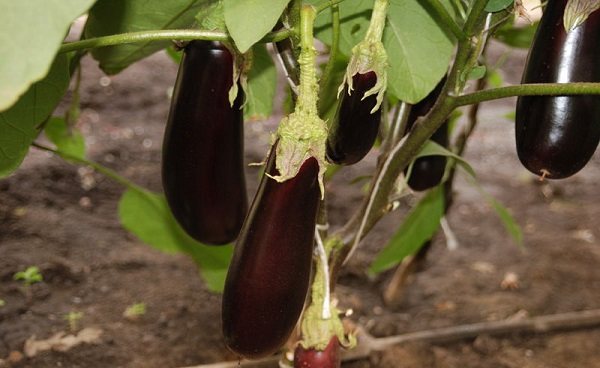

Transportability and safety of eggplants are high. The culture is resistant to pests (spider mites), diseases, especially verticillium. The purpose of the fruits is very different - from appetizers and second courses to pickling, pickling and even freezing.
Reviews of summer residents
Reviews of vegetable growers often speak in favor of hybrids.
Maria, Vologda region: “Every year, besides the usual ones, I plant vegetables of interesting colors for the sake of experiment. Of the eggplants, I liked the Purple Miracle F1 and Sailor. The latter is not as fruitful as Miracle, but it is painfully beautiful! "
Elena, Omsk: “I have been growing eggplants for a long time. In my greenhouse, I grow both purple and white varieties. I would like to say a separate word about the Bibo F1 hybrid. Withstands both cold and heat. Doesn't get sick and doesn't require a lot of trouble. Its taste is mushroom, soft. Even my children eat it, although other eggplants do not like it. "

